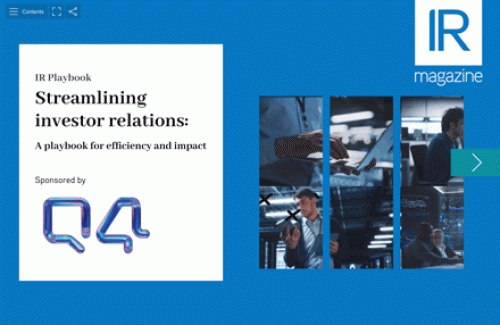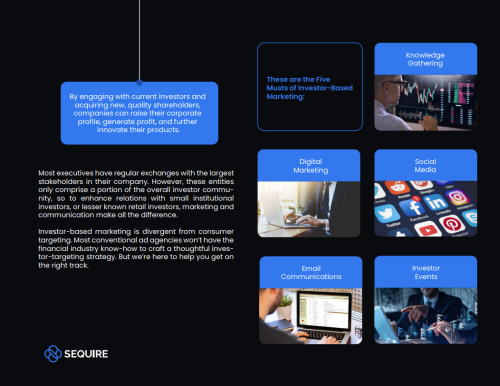IROs should consider video training whether they’re in front of the camera or behind it
When Canada’s ARC Energy Trust wanted video content for its IR website, it could have spent several thousands of dollars on a single video. Instead, inspired by research done by a young staffer, ARC’s IR team earmarked $5,000 for its own high-definition video camera and lighting equipment.
So far this year, the firm has posted videos of a Q&A with CEO John Dielwart on the website every quarter, along with excerpts from the annual meeting, and has made DVDs of quarterly boardroom updates for employees. The company’s next blockbuster: an updated virtual site tour, shot and edited in-house.
‘I don’t think we’re up for any Oscars or Emmys,’ laughs David Carey, ARC’s senior vice president of capital markets and head of IR. ‘But we are making the most of the camera and the people we have available.’ There are clear cost savings to ARC’s DIY approach. Another motivation is the ability to make timelier videos. ‘If something’s going on, we can film it and get the video up right away,’ Carey explains.
Con Edison, New York’s venerable $12 bn power company, produces professional videos, like its recent Power of Green videos. But in 2008, with YouTube blossoming alongside interest in low-cost Flip video camcorders, chairman and CEO Kevin Burke prompted the communications team to start making its own web videos for a new internal news channel called CE Eye, aimed at Con Edison’s 15,000 employees. The program has averaged one and a half videos a week, with some posted publicly (see the playlist at www.coned.com/videos).
Communications staff shoot the videos themselves and sometimes lend Flip cameras to other employees to gather footage. While a professional video editor from the company’s corporate video team helps out, the communications team is learning how to edit and add music and titles. Maria Smith, CE Eye editor, says her team picked up along the way what works and what doesn’t.
CE Eye’s magic is that it doesn’t try to be slick. The videos are cleverly shot and edited but are clearly amateur productions. ‘We have a robust communications team with a long track record in corporate video, but we wanted CE Eye to be different: fast, cinema verité, with a YouTube spirit,’ explains Fred Leich, section manager for public affairs. ‘It’s about getting the information out there quickly; that’s its charm.’
To DIY or not to DIY
Justin Allen, who provides video workshops and webinars for Ragan Communications, based in Chicago, applauds Con Edison’s approach. ‘You immediately lose a bit of authenticity when you hire an outside production house to tell an internal story,’ he says, ‘A Flip gives that social media feel: it’s not the most polished video in the world – but it is real.’
Do-it-yourself videos have their place in internal communications, but IR needs professionally produced videos, argues Stephen Watson, founder and CEO of CTN Communications, one of the UK’s top 10 corporate production companies. ‘Of course video production has been democratized; anyone can YouTube anything,’ he says. ‘But investors and analysts are very demanding and discerning. No one will thank you for dabbling. That’s just noise.’
With video now central to many companies’ communications, however, IROs need to be video-literate, even if they never pick up a camera. ‘IROs have always taken on the role of director and producer,’ Watson says. ‘My advice is not to obsess about how it’s going to be shot and lit, but to be clear about the added value you’re seeking to provide through this medium.’ For example, for Cadbury’s award-winning takeover defense against Kraft, CTN dispatched crews to India and Brazil, using ‘the trade craft of TV professionals to make powerful pieces of TV purely for defense communication.’
Jon Greer, managing director of San Francisco’s Jon Greer Consulting, an investor communications and media training firm, is more blunt. ‘I don’t think you’re ever going to see video shot by IROs themselves in investor communications,’ he predicts. ‘Go polished; it doesn’t have to cost a lot.’
Greer concedes ‘there’s a lot of learning to be done’ by PR and IR people. They should know about video fundamentals and be able to select vendors but they should stick to spokesperson training, such as doing mock shoots with professional cameramen.
He points to a recent Dell ‘vlog’ or video blog (www.youtube.com/watch?v=yO-4ALG2Taw) with IR director Rob Williams interviewing chief financial officer Brian Gladden and Brad Anderson, senior vice president of Dell’s enterprise product group, about the latest quarter’s performance. Williams is terrific on camera, and the unscripted responses of his senior management make for a credible and engaging production. By contrast, Cisco recently posted a video of CFO Frank Calderoni stiffly reading what sounds like a press release, which adds little to the Cisco story.
Degrees of engagement
At VET, a production and training facility in London, director of training Joan Leese says clients are getting into video to varying degrees: some have trained up employees to produce videos entirely themselves, while others shoot video then bring the footage to VET for post-production.
Leese echoes the other experts: for an important video representing a corporate brand, leave it to the pros. But she agrees that communications professionals can benefit from training. Her students leave feeling ‘empowered’, astute critics of corporate videos who understand the process, whether or not they go on to make videos themselves.
Find your inner Spielberg
DO
- Prepare your story, script and shot list, even for short, simple videos.
- Use an external lapel mic or handheld mic; it will yield much better audio than one built into your camera. For social media-style videos, Justin Allen of Ragan Communications recommends the Kodak Zi8 camera.
- Remember the difference good lighting makes: especially when using a Flip, use as much natural light as possible.
- Use a tripod whenever you can, and absolutely always when using a Flip.
- Shoot lots of ‘b-roll’ to intersperse with your talking heads. Simple text bullets or charts will do if you can’t get your hands on more colorful footage.
- Keep it short: follow the three-to-five minute rule (fast becoming the one-to-two-minute rule).
Don’t
- Make a video just for the sake of it. Start by asking yourself what video can deliver that another medium can’t.
- Let noises like air conditioning, office equipment or background chatter get in the way. For key interviews, find a room with quiet ventilation and switch off computer and telephone equipment.
- Forget that dark shadows, especially on your subject, make for poor video.
- Risk nausea-inducing shakes. The staple walk-and-talk shot works with high-end cameras, but not with a Flip.
Training options
- Chicago-based Ragan Communications has a near lock on live and webinar video training for PR and internal communications professionals in the US. Workshops are held around the country and cater to different levels, from quick Flip workshops to classes on camera, lighting, sound and planning and scripting web videos.
- Media trainers focus on spokesperson training, with the assumption that companies will hire pros for camera work and post-production.
- VET is a London-based video production company that also offers video training to clients.
- Write & Rewrite (http://writeandrewriteblog.com), run by former Ragan consultants, is ramping up its webinar-based training.
- ARC Energy was given a free day of training from the store where it bought its HD camera.
- Web-based video tutorials are great, especially for editing. Check out www.lynda.com, a subscription-based software training site. Free tutorials are also easy to find on YouTube.
- If you use a Mac for editing and visual effects, take advantage of the free workshops at Apple retail stores.










